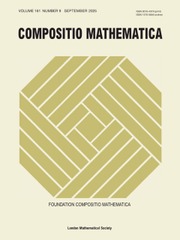Article contents
Classification of finite-dimensional irreducible modules over  $\def \xmlpi #1{}\def \mathsfbi #1{\boldsymbol {\mathsf {#1}}}\let \le =\leqslant \let \leq =\leqslant \let \ge =\geqslant \let \geq =\geqslant \def \Pr {\mathit {Pr}}\def \Fr {\mathit {Fr}}\def \Rey {\mathit {Re}}W$-algebras
$\def \xmlpi #1{}\def \mathsfbi #1{\boldsymbol {\mathsf {#1}}}\let \le =\leqslant \let \leq =\leqslant \let \ge =\geqslant \let \geq =\geqslant \def \Pr {\mathit {Pr}}\def \Fr {\mathit {Fr}}\def \Rey {\mathit {Re}}W$-algebras
Published online by Cambridge University Press: 07 April 2014
Abstract
Finite  $W$-algebras are certain associative algebras arising in Lie theory. Each
$W$-algebras are certain associative algebras arising in Lie theory. Each  $W$-algebra is constructed from a pair of a semisimple Lie algebra
$W$-algebra is constructed from a pair of a semisimple Lie algebra  ${\mathfrak{g}}$ (our base field is algebraically closed and of characteristic 0) and its nilpotent element
${\mathfrak{g}}$ (our base field is algebraically closed and of characteristic 0) and its nilpotent element  $e$. In this paper we classify finite-dimensional irreducible modules with integral central character over
$e$. In this paper we classify finite-dimensional irreducible modules with integral central character over  $W$-algebras. In more detail, in a previous paper the first author proved that the component group
$W$-algebras. In more detail, in a previous paper the first author proved that the component group  $A(e)$ of the centralizer of the nilpotent element under consideration acts on the set of finite-dimensional irreducible modules over the
$A(e)$ of the centralizer of the nilpotent element under consideration acts on the set of finite-dimensional irreducible modules over the  $W$-algebra and the quotient set is naturally identified with the set of primitive ideals in
$W$-algebra and the quotient set is naturally identified with the set of primitive ideals in  $U({\mathfrak{g}})$ whose associated variety is the closure of the adjoint orbit of
$U({\mathfrak{g}})$ whose associated variety is the closure of the adjoint orbit of  $e$. In this paper, for a given primitive ideal with integral central character, we compute the corresponding
$e$. In this paper, for a given primitive ideal with integral central character, we compute the corresponding  $A(e)$-orbit. The answer is that the stabilizer of that orbit is basically a subgroup of
$A(e)$-orbit. The answer is that the stabilizer of that orbit is basically a subgroup of  $A(e)$ introduced by G. Lusztig. In the proof we use a variety of different ingredients: the structure theory of primitive ideals and Harish-Chandra bimodules for semisimple Lie algebras, the representation theory of
$A(e)$ introduced by G. Lusztig. In the proof we use a variety of different ingredients: the structure theory of primitive ideals and Harish-Chandra bimodules for semisimple Lie algebras, the representation theory of  $W$-algebras, the structure theory of cells and Springer representations, and multi-fusion monoidal categories.
$W$-algebras, the structure theory of cells and Springer representations, and multi-fusion monoidal categories.
Keywords
MSC classification
Information
- Type
- Research Article
- Information
- Copyright
- © The Author(s) 2014
References
- 9
- Cited by

